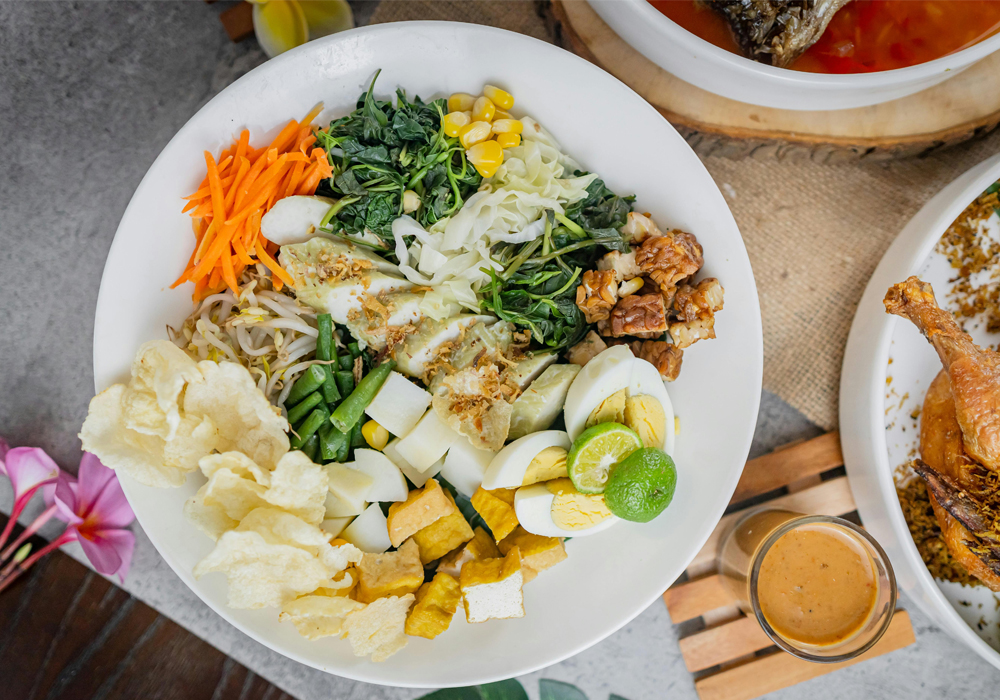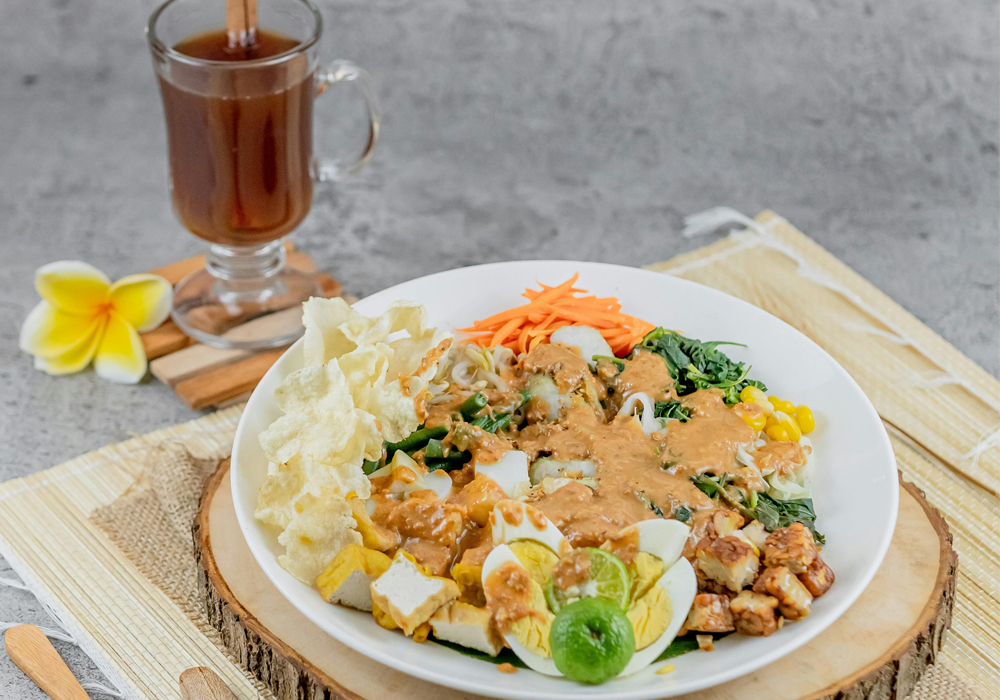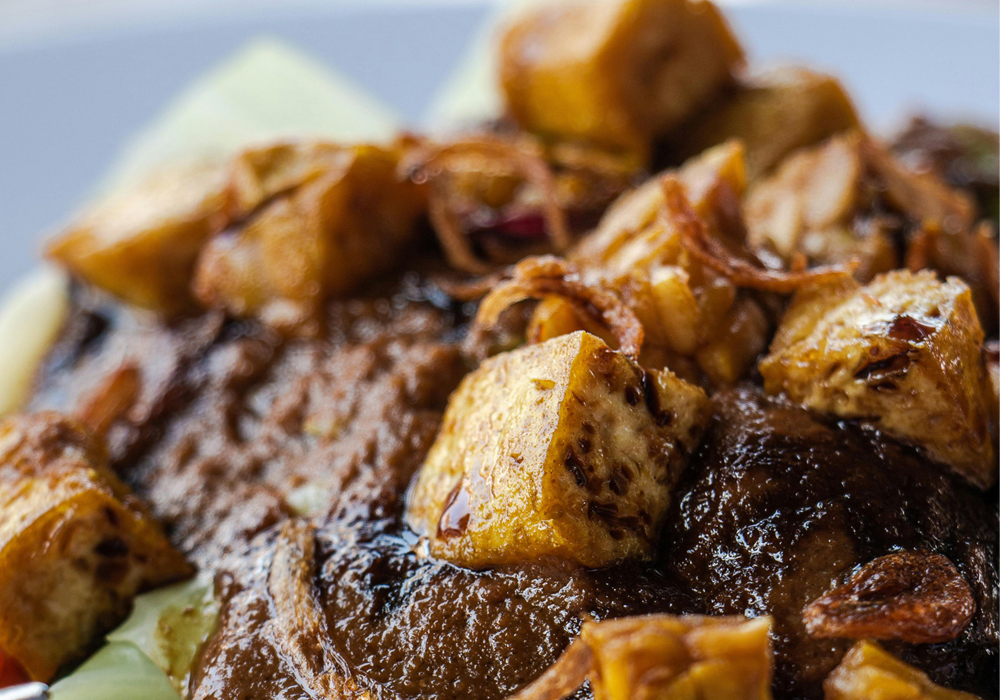Gado-gado as Indonesian street food salad. Imagine a salad so rebellious, so full of personality, it laughs in the face of blandness and stares down the most committed vegetable-skeptic. That, my friends, is Gado-Gado. It’s not just a dish; it’s a vibrant, saucy, crunch-tastic culinary event that deserves a standing ovation and perhaps its own dramatic theme music.
What in the World is This Glorious ‘Mix-Mix’?
So, what kind of food is this magnificent beast? Well, technically, Gado-Gado is an Indonesian salad. But don’t let that humble term fool you. If a typical Western salad is a quiet, polite gathering of leaves, Gado-Gado is a full-blown carnival crashing into a spa retreat.
The name itself, “Gado-Gado,” literally translates to “mix-mix” in Indonesian, which is wonderfully appropriate because it’s a beautiful, chaotic mix of textures and temperatures. You’ve got slightly-blanched, crisp vegetables sitting right next to cool, fresh cucumber, cozying up with warm slices of fried tofu and tempeh, and all of it is smothered, absolutely smothered, in a thick, rich, sweet, savory, and spicy peanut sauce.

It’s a culinary hug that simultaneously slaps you awake with flavor. Forget your sad, watery vinaigrettes; this is a peanut dressing so decadent, it probably has its own fan club.
A Star is Born: The Origin Story
Where does this superstar come from? Gado-Gado proudly hails from Indonesia, and its heartland is generally considered to be Jakarta, the bustling capital city. It’s a true representative of the local Betawi culture, the indigenous people of Jakarta.
The dish has a long, flavorful history and became a popular street food staple, often sold by cheerful vendors. There’s a fun linguistic twist, too, as some suggest the term gado or menggado in Betawi language means “to eat something without rice.”
While it’s often served with lontong or ketupat (compressed rice cakes) today, the essence remains: this isn’t a side dish; it’s the main attraction, full of enough heft and flavor to stand alone.
While it originated in Jakarta, asking which part of Indonesia Gado-Gado is most eaten is a bit like asking which part of the world loves a good joke—it’s everywhere! It is incredibly popular across the whole archipelago, but its prominence and local variations are particularly strong in Java (where Jakarta resides).
You can find fantastic versions of it from the streets of Bali to the warungs (small local eateries) in Yogyakarta, proving it’s a national darling, one of Indonesia’s iconic “must-try” dishes.
The Diet Food Debate: A Healthy Dilemma
Now, for the big question: Is this magnificent creation a diet food? Well, let’s be brutally honest. At its core, Gado-Gado is a powerhouse of nutrition.
It’s a literal mountain of fresh or lightly cooked vegetables—spinach, cabbage, long beans, bean sprouts, sometimes potato—along with high-protein heroes like hard-boiled eggs, tofu, and tempeh (fermented soybeans, a superfood in disguise!).
It’s fiber-rich, packed with vitamins, and boasts a great balance of macronutrients. So, yes, from a vegetable and protein standpoint, it’s incredibly healthy!
However, the peanut sauce—oh, that glorious, creamy, irresistible peanut sauce—is where things get… deliciously complicated. Made with roasted peanuts, palm sugar (or coconut sugar), tamarind, chilies, and often a touch of savory shrimp paste (terasi), it’s rich, calorie-dense, and utterly vital to the dish’s soul.
Think of it less as a “diet” food and more as a “nutritious, filling, and incredibly satisfying meal” that’s a far sight better than many deep-fried alternatives. It’s healthy with a fabulous attitude.
Why Foreigners Should Dive In Headfirst
Why should any traveler or food adventurer from outside Indonesia rush to try Gado-Gado? Simple: It’s the flavor equivalent of a tropical vacation.
- It’s the Perfect Introduction to Indonesian Cuisine: It showcases the cuisine’s brilliant balance of sweet, sour, salty, and spicy in one bowl, all centered around the ubiquitous, comforting peanut flavor.
- It’s a Vegetarian Dream: For those seeking plant-based options, Gado-Gado is a delicious and hearty meal that doesn’t feel like a compromise, thanks to the satisfying protein from tempeh and tofu.
- The Texture Party: It’s a joyful clash of textures—the crunch of fresh cucumber and crackers (krupuk), the tenderness of blanched veggies, the firmness of tempeh, and the silky smoothness of the sauce.
- It’s Versatile: You can tweak the spice level, swap in different seasonal vegetables, or add lontong to make it even more substantial. It adapts to you, not the other way around.
- It’s Authenticity on a Plate: Skip the tourist traps. Eating Gado-Gado from a local warung or street vendor is tasting the true, everyday flavor of Indonesia.
The Cost of Culinary Happiness
Is Gado-Gado expensive to make? The fantastic news is, no! This is one of its major charms. The ingredients are largely staples—common local vegetables, affordable protein sources like tofu and tempeh, and peanuts.

In Indonesia, it’s known as an affordable, everyday meal, which is a testament to the accessibility of its components. Even when using a variety of fresh vegetables, the cost per serving remains relatively low, making it a great budget-friendly option for home cooks and a cheap, delicious street eat for travelers.
The biggest investment, perhaps, is the time and love needed to grind the perfect peanut sauce, but that’s a flavor investment that pays massive dividends.
The Delicious Secret: Why It Works
The ingredients of Gado-Gado are a harmonious blend of simple things elevated to superstar status:
- Blanched Vegetables: Long beans, bean sprouts, cabbage, spinach, and sometimes chayote. Lightly cooked to retain their crunch and vibrant color.
- Hearty Additions: Boiled potatoes (for carb-love), hard-boiled eggs, fresh cucumber, and tomato.
- The Protein Power-Up: Cubes of fried tempeh (fermented soybeans, nutty and firm) and tofu (soybean curd, soft and absorbent).
- The Crown Jewel: The Peanut Sauce (Bumbu Kacang): This is where the magic happens. It’s a masterful blend of ground roasted peanuts, palm sugar (for sweetness and depth), tamarind (for tangy sourness), chili peppers (for the essential kick), garlic, and often a touch of shrimp paste (terasi) for a deeply savory, umami complexity.
Why does it taste delicious? Because it hits all five flavor receptors with the precision of a culinary ninja:
- Sweetness from the palm sugar.
- Salty/Umami from the paste/soy sauce/salt.
- Sourness from the tamarind and lime juice.
- Spiciness from the chili peppers.
- Richness/Nutty comfort from the roasted peanuts.
This dynamic tension between the flavors, combined with the exciting textural contrast (soft, firm, creamy, crunchy!), makes Gado-Gado addictive.
It’s a complete meal that stimulates every part of your palate, leaving you thoroughly satisfied and ready for a nap. Go on, give this ‘mix-mix’ a try. Your taste buds will thank you, probably with a little Indonesian dance.
